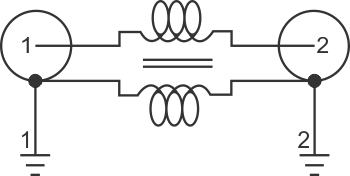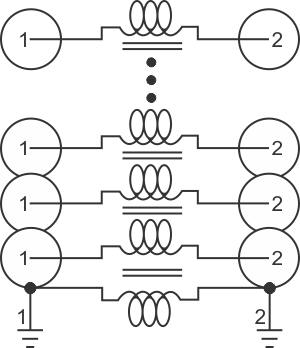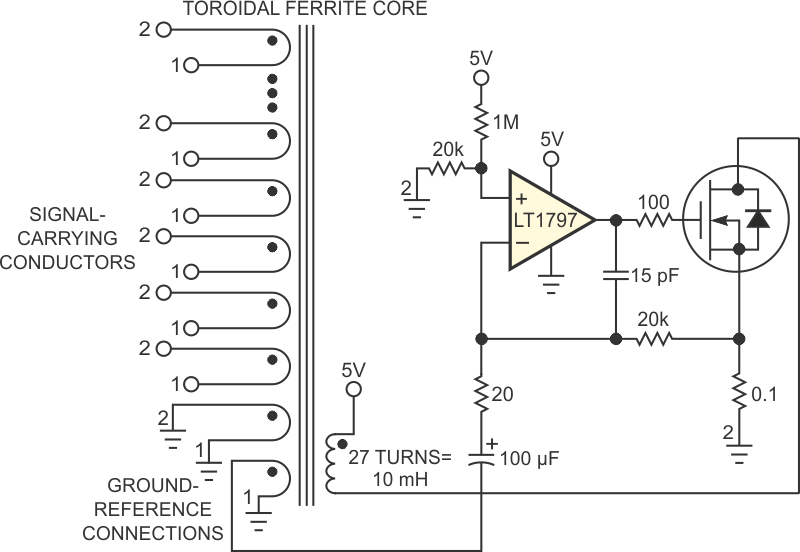An earlier Design Idea illustrated one approach to that traditional headache for the analog designer: the dreaded ground loop (Reference 1). That Design Idea described a simple and efficient multichannel circuit. But it’s an asymmetrical CMV (common-mode-voltage) approach in that it works only at the receiving end of a cable. It therefore applies only to signal inputs and does nothing for outputs. However, in cases in which CMV consists of purely ac noise, a different CMV-remediation method – active inductive cancellation – works bidirectionally and therefore cancels CMV-error components in both input and output signals.
Engineers have for many years used passive-CMV inductive cancellation (Figure 1). Sometimes called a “humbucker transformer” because the power mains’ 60-Hz “hum” is often a dominant CMV component, the CMV inductor comprises a primary winding in series with the ground connection between the signal source (1) and the destination (2) and a secondary winding with a 1-to-1 turns ratio.
 |
||
| Figure 1. | In the classic humbucker configuration, the CMV inductor comprises a primary winding in series with the ground connection between a signal source (1) and a destination (2) and a secondary winding with a 1-to-1 turns ratio. |
|
The principle of the CMV transformer relies on magnetic coupling between the primary and the secondary, such that any voltage that appears across the primary induces an equal and opposite voltage in the secondary, thus canceling it. You can easily extend the principle to multiple signal channels simply by adding more secondary windings – one secondary for each channel (Figure 2).
 |
||
| Figure 2. | You can extend the passive approach in Figure 1 to multiple channels at the expense of a large magnetic component. |
|
However, the Achilles’ heel of the CMV transformer is the fact that the decibels of cancellation fall off at the low-frequency end of the noise spectrum. This situation occurs because noise cancellation depends on the fact that the inductive reactance of the windings must be much larger than the impedance of the cable. Hundreds of millihenries of inductance are necessary to satisfy this criterion for frequencies as low as 60 Hz. For multichannel applications requiring cancellation for frequencies as low as 60 Hz, this fact translates to lots of copper, core, bulk, and weight. However, if you don’t mind if your designs consume a little power, then a work-around exists: actively driving the CMV core.
 |
||
| Figure 3. | Using the active drive of the CMV core, you can achieve CMV reduction of 40-dB or more cancellation, extending from tens to millions of hertz. |
|
In Figure 3, the power amplifier comprising the LT1797 high-frequency op amp and MOSFET forces the driven core to precisely cancel CMV as sensed in the ground-reference connection. The result is such a large multiplication of the apparent winding inductance that you can reduce the “windings” to a simple single pass-through of the toroid core. In other words, you need to thread a multiconductor-signal cable only once through the “hole in the doughnut” to achieve CMV of 40-dB or more cancellation, extending from tens to millions of hertz.